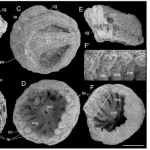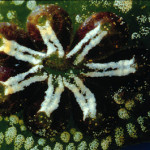![]() A recent PLoS One paper by Birky and colleagues attempts to define species for asexual animals using the theoretical framework that has been developed by population geneticists. Many species concepts focus on reproductive isolation and are not applicable for defining what is necessary and sufficient for delimiting what species are in non-sexually reproducing organisms slike some fungi, protists or even multicellular animals like crayfish, certain mites and rotifers.
A recent PLoS One paper by Birky and colleagues attempts to define species for asexual animals using the theoretical framework that has been developed by population geneticists. Many species concepts focus on reproductive isolation and are not applicable for defining what is necessary and sufficient for delimiting what species are in non-sexually reproducing organisms slike some fungi, protists or even multicellular animals like crayfish, certain mites and rotifers.
For this week’s ResearchBlogCast I chose the Birky paper after reading about it on the Marmorkrebs blog by Zen Faulkes. You can listen to the ResearchBlogCast at ResearchBlogging.org, where each week Razib Khan, Dave Munger and I discuss a peer-reviewed article from the RB aggregator.
Birky, C., Adams, J., Gemmel, M., & Perry, J. (2010). Using Population Genetic Theory and DNA Sequences for Species Detection and Identification in Asexual Organisms PLoS ONE, 5 (5) DOI: 10.1371/journal.pone.0010609
In many asexual taxa, DNA sequences alone are used to detect and assign species, but this is only meaningful in the context of a well-defined species concept that you are blatant about operating under. I say “operating under” because I personally feel that scientists need to recognize that different species concepts are useful under different scenarios or for different taxa. This is called pluralism in the species concept literature. Many biologist from the ecology and evolutionary biology are not forthcoming about what species concept(s) they are operating under when they write up their results.
The new framework being proposed draws on previous work by the authors characterizing the mode of speciation in bdelloid rotifers. They updated their model to make it more general to other asexually reproducing taxa. Birky and colleagues refer to it as the 4x rule and argue that clades are sufficiently diverged by a number of generations equal to 4 times the effective population size. At this genetic distance, speciation is deep enough to be discerned from random genetic drift and other stochastic processes. It does not have to be exactly 4 times, but is actually the ratio of the average sequence diversity between groups to the nucleotide diversity among individuals within a groups. The point being that this is when two clades are reciprocally monophyletic at a statistical probability of 95% confidence.
What these authors try to do is introduce a rigorous way to define species that is based in existing theory. They differentiate this from DNA barcoding because the barcoding approach identifies species already defined by traditional taxonomy and uses empirically determined limits, not justified by any theoretical foundations. This also differs from traditional taxonomy because the authors feel that discernible phenotypes need not be present to distinguish between species, only reciprocal monophyly.
What I don’t really understand yet is how this really differs from the phylogenetic species concepts of the 1980s and ’90s. It may be that the population genetics species concept present a more rigorous and less subjective way to define species within a phylogenetic species concept. For instance, 2 closely-related taxa that are on the verge on being an obvious phylogenetic species may be discerned by using Birky and colleagues methodology as a decision rule.






I don’t quite follow this part, “Birky and colleagues … argue that clades are sufficiently diverged by a number of generations equal to 4 times the effective population size.” What exactly does this mean? (I listened to the blogcast!) Can you elaborate on this please?
No problem DeLene. For the record, I went back and checked out the comments on the article at PLoS One and Birky made the following suggestion regarding the 4x rule on July 21:
I downloaded the article before this comment was posted a week ago, or else I would used this terminology which is more clear.
The 4x rule means that at a 95% level of certainty, this would be the phylogenetic distance that 2 clades would need to be apart to be sufficiently diverged. We didn’t get into the math, but this figure from the paper visually shows the model. The estimate of “within-clade” genetic diversity is Theta and is estimated, by doing some equation rearranging, 2Neu, where Ne is the effective population size and u is the mutation rate of the gene. So if Ne is the number of breeding individuals in a population in a generation, 4 times this amount of generations is what the authors argue should be sufficient time for the two clades to diverge. Does this help or confuse you more?
Thanks Kevin. In the linked graphic, are the individual lines within what is being called a clade representative of a populations (so the whole clade is a meta-population?) I’m used to thinking of each twig on those branches as species, but this tree seems to be saying the twigs are populations?
I guess one thing I don’t fully understand is the “4 times this amount of generations” part… So, if Ne is the proportion of the population that are breeders, then do you need 4 times their number? Or 4 times the average amount of offspring they produce (a generation)?
And I understand from the blogcast that this was developed more for non-sexually reproducing organisms, but do you think this has any application for very small meta-populations, like with endangered species?
Thanks for humoring me.
Hey Delene,
If I understand the paper (I’ll admit it’s a bit beyond my level) then the twigs (or at leas the tips) are individuals sampled from what may or may not be two species. The test then is whether any of the clades identified in the tree are so far apart from each other they are unlikely to have arisen by chance (so represent species in the Simpson sense of “independently evolving lineages”)
The 4Ne bit comes from the population genetics. The set up is that on average a contiguous population will contain lineages that are 2Ne generations apart from each other (it sort of stands to reason than in a small population everyone is more closely related). As it happens, you only have a 5% chance of finding a lineage that goes back 4Ne generations within a contiguous population so that’s the cut they’ve used in this paper.
I guess they would argue that’s also the difference between their method and the Phylogenetic Species Concepts – rather than being monophyly + some diagnosable character it’s a cut off derived from population genetics.
Does that help at all?
It does — thanks David!
I am glad that Delene brought that question up. And hey Kevin thanks to you too. What I like the most about this site is, if readers like me get any doubts or questions, the authors never fail to give us more information. Good Job really!